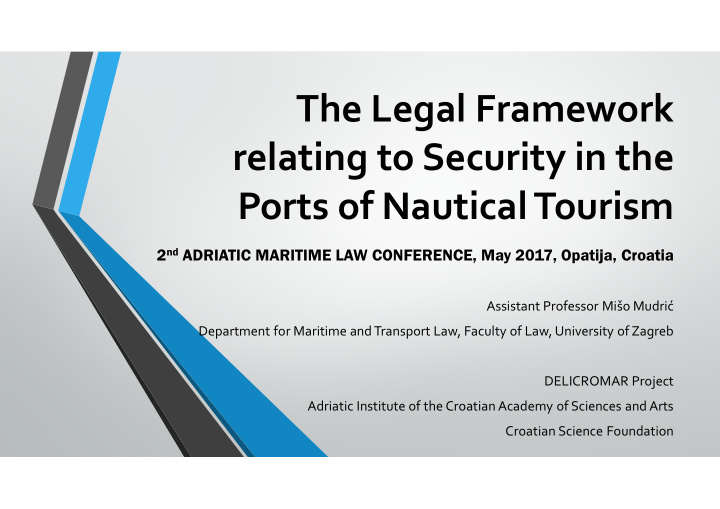



The Legal Framework relating to Security in the Ports of Nautical Tourism 2 nd ADRIATIC MARITIME LAW CONFERENCE, May 2017, Opatija, Croatia Assistant Professor Mišo Mudrić Department for Maritime and Transport Law, Faculty of Law, University of Zagreb DELICROMAR Project Adriatic Institute of the Croatian Academy of Sciences and Arts Croatian Science Foundation
General Framework • SOLAS Convention – XI-2 Chapter – Special Measures to Enhance Maritime Security • ISPS Code – International Ship and Port Facility Security Code • Regulation (EC) No 725/2004 on enhancing ship and port facility security • Directive 2005/65/EC on enhancing port security • Security Protection of Maritime Vessels and Ports Act • Maritime Demesne and Maritime Ports Act • Private Security Act • By-Law on conditions and methods of enforcing technical protection • By-Law on arrangement and classification of ports of nautical tourism • …
General Nautical Data • State Bureau for Statistics (2016) • 139 ports of nautical tourism – 71 marinas and 69 other ports • Overall space volume = 3.7 m 2 , over 17.400 mooring berths • Continuous berth : 13.422 vessels (little more than half are motor yachts, little less than half are sailing yachts) • Transit vessels : 3 counties (Split-Dalmatian, Šibenik-Knin and Zadar) = over 135.000, 13,1% annual increase; in total: over 198.000 vessels , 8,6% annual increase • Flags: majority under Croatian flag, other dominant flags: Austria, Germany, Italy and Slovenia • Total income: 796 million HRK; 70% berthing (4% annual increase) • eCrew system (Ministry of Tourism, January-September 2016) • Nautical guests – 410.541 arrivals and 2,84 million overnight stays
Practical Issues • Ports of nautical tourism that employ private protection service providers: • Control of entry and exit • Right to prevent free access to the port area? • Protection of infrastructure • Protection of guests’ property • Does this include boats, vessels etc . anchored in the port area, and to what extent? • Protection of people and property through constant supervision and control • Scope of rights and powers to act? Responsibility and liability for poor performance or non-performance? • Is it necessary to provide both the physical and technical protection?
Security Protection of Maritime Vessels and Ports Act (2012) (i) • Art. 2, para 1, p. 6 – definition of security protection • A system of preventive measures aimed to protect a vessel and port from threats of intentional unlawful conduct • What about negligent conduct or omission resulting in damage? • Art. 25 • Security in the special purpose ports (including the ports of nautical tourism) => responsibility of the concessionaire • Necessary to establish a port security protection service organization
Security Protection of Maritime Vessels and Ports Act (2012) (ii) • Art. 26 • Port of nautical tourism security risk assessment plan => responsibility of the concessionaire (in accordance with the Annex 4) • To be approved by the Ministry of the Sea, Transport and Infrastructure (prior opinion by the Ministry of Interior) • Art. 27 • Port security protection plan • Based on the risk assessment, cannot be prepared by the same organization in charge of risk assessment preparation • To be approved by the Ministry of the Sea, Transport and Infrastructure (prior opinion by the Ministry of Interior) • Art. 29 – security levels (1 – basic level, 2 – increased threat, 3 – high probability of threat occurring)
By-Law on arrangement and classification of ports of nautical tourism (2008) • Art. 2 – Port of nautical tourism definition: • Business-functional complex in which a legal or physical person conducts business and provides tourism services in nautical tourism and other services in function of tourist spending (commercial, catering and other) • Art. 11 – general conditions, including: secure movement of tourists and staff • Porter/reception services (0-24h) and seamen-protection service requirements, if ports are categorized for specific categories, such as ports of nautical tourism • What is „seamen-protection service”? Contractual based definition or general legal requirements? • General liability in accordance with lex generalis , or contractual determination of liability division?
Private Security Act (2010) (i) • Categories and conditions with regard the provision of private security services • Art. 27 et cet – physical protection • Rights and powers: identification, issuing warnings and orders, limitation of movement, bodily and property examination, use of force (including lethal weapons) … • Gradual, proportional, selective, exceptional and necessary use of force • Art. 43 et cet – technical protection • Anti-theft, unlawful entry, unlawful entry of forbidden materials… means and mechanisms …
Private Security Act (2010) (ii) • Art. 9 – Responsibility and Liability • Damage compensation, private security service provider’s employees, contractual and non-contractual (third party) liability, conduct contrary to the Act and other relevant legislation – strict liability principle • Recourse right against employees – if intent or gross negligence • Problem 1: status of employees -> technical protection contractors = possiblty to use their services under the contract of result • Solution: general contractual and non-contractual liability norms in Obligations Act • Problem 2: so-called „ dangerous activities ” as opposed to the necessity to prove unlawful conduct?
Thank you for attention!
Recommend
More recommend